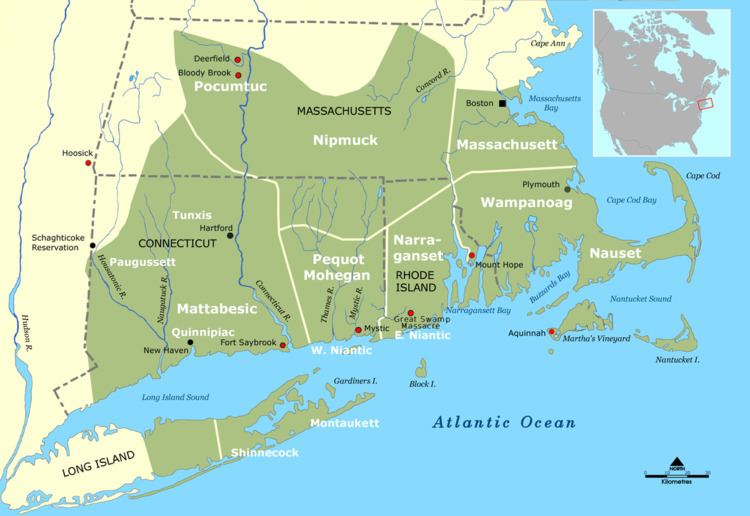ISO 639-3 qyp | Extinct ca. 1900 Glottolog wamp1250 | |
 | ||
Language family AlgicAlgonquianEastern AlgonquianQuiripi | ||
Quiripi (pronounced /ˈkwɪrᵻpiː/, also known as Quiripi-Unquachog, Quiripi-Naugatuck, and Wampano) was an Algonquian language formerly spoken by the indigenous people of southwestern Connecticut and central Long Island, including the Quinnipiac, Unquachog, Mattabesic, Podunk, Tunxis, and Paugussett (subgroups Naugatuck, Potatuck, Weantinock). It has been effectively extinct since the end of the 18th century, although Frank T. Siebert, Jr., was able to record a few Unquachog words from an elderly woman in 1932.
Contents
Affiliation and dialects
Quiripi is considered to have been a member of the Eastern Algonquian branch of the Algonquian language family. It shared a number of linguistic features with the other Algonquian languages of southern New England, such as Massachusett and Mohegan-Pequot, including the shifting of Proto-Eastern Algonquian */aː/ and */eː/ to /ãː/ and /aː/, respectively, and the palatalization of earlier */k/ before certain front vowels. There appear to have been two major dialects of Quiripi: an "insular" dialect spoken on Long Island by the Unquachog and a "mainland" dialect spoken by the other groups in Connecticut, principally the Quinnipiac.
Attestation
Quiripi is very poorly attested, though some sources do exist. One of the earliest Quiripi vocabularies was a 67-page bilingual catechism compiled in 1658 by Abraham Pierson, the elder, during his ministry at Branford, Connecticut, which remains the chief source of modern conclusions about Quiripi. Unfortunately, the catechism was "poorly translated" by Pierson, containing an "unidiomatic, non-Algonquian sentence structure." It also displays signs of dialect mixture. Other sources of information on the language include a vocabulary collected by Rev. Ezra Stiles in the late 1700s and a 202-word Unquachog vocabulary recorded by Thomas Jefferson in 1791, though the Jefferson vocabulary also shows clear signs of dialect mixture and "external influences." Additionally, three early hymns written circa 1740 at the Moravian Shekomeko mission near Kent, Connecticut, have been translated by Carl Masthay.
Phonology
Linguist Blair Rudes attempted to reconstitute the phonology of Quiripi, using the extant documentation, comparison with related Algonquian languages, as "reconstructing forward" from Proto-Algonquian. In Rudes' analysis, Quiripi contained the following consonant phonemes:
Quiripi's vowel system as reconstituted by Rudes was similar to that of the other Southern New England Algonquian languages. It consisted of two short vowels /a/ and /ə/, and four long vowels /aː/, /iː/, /uː/, and /ʌ̃/.
